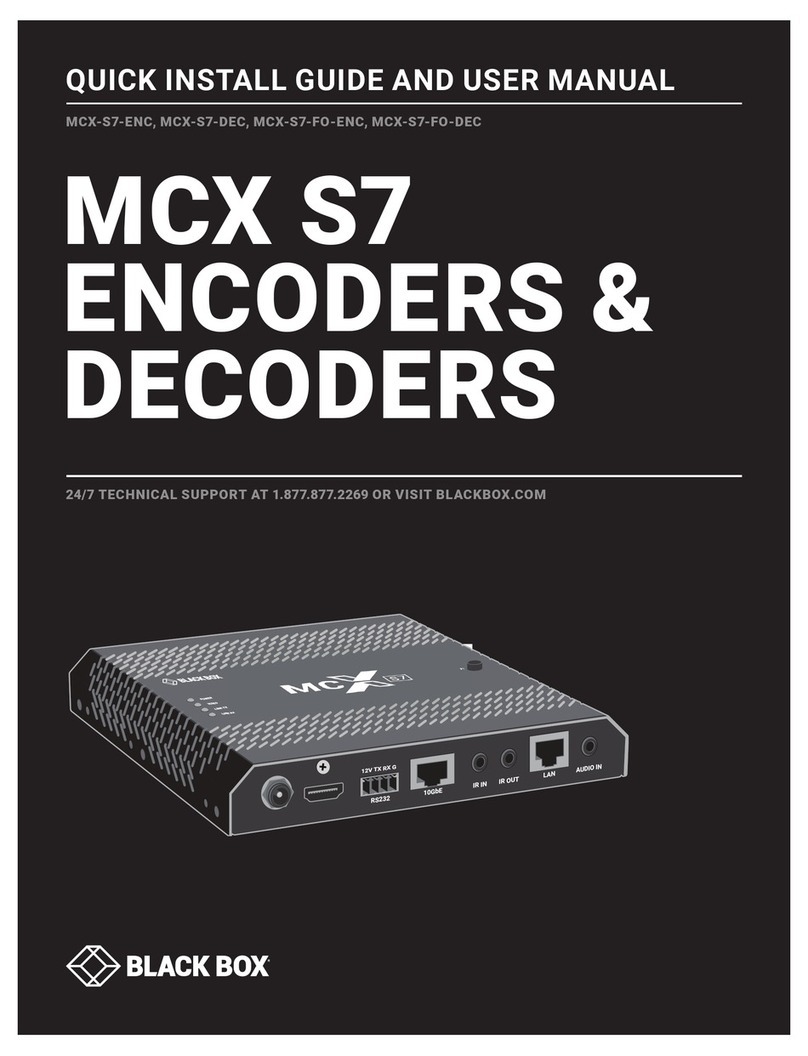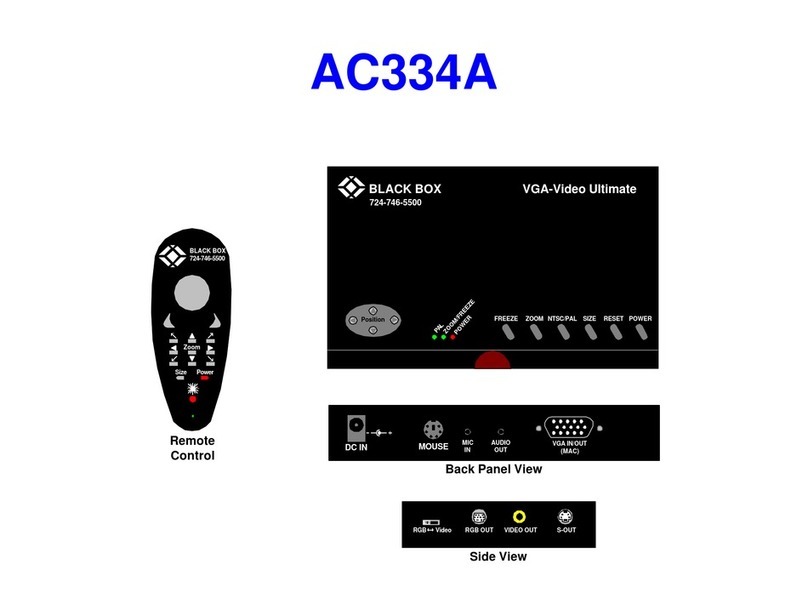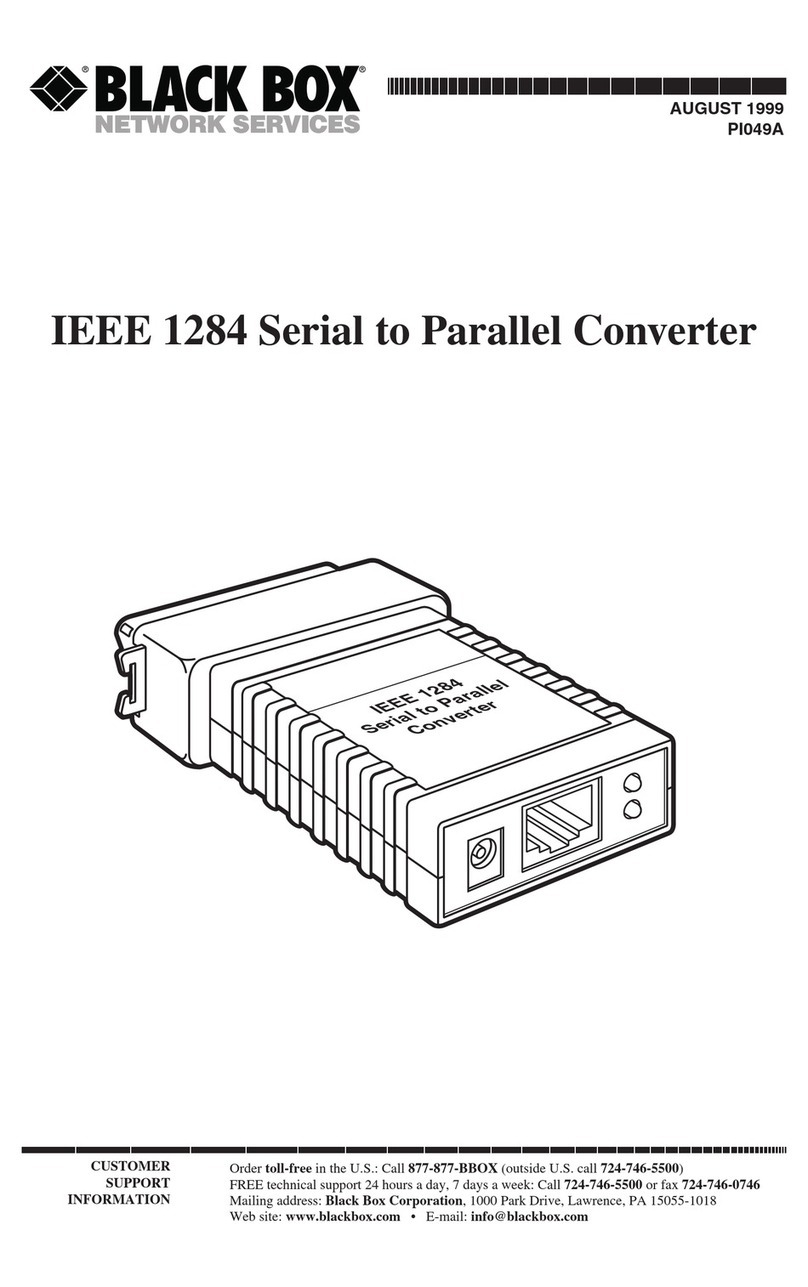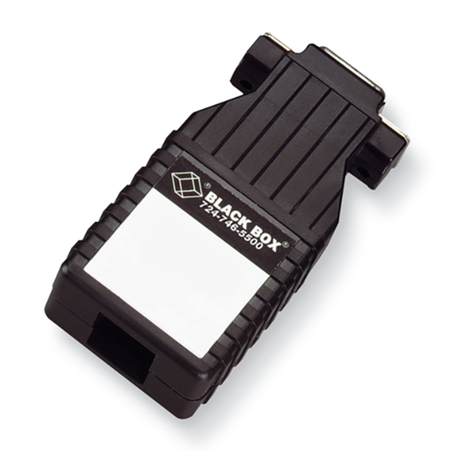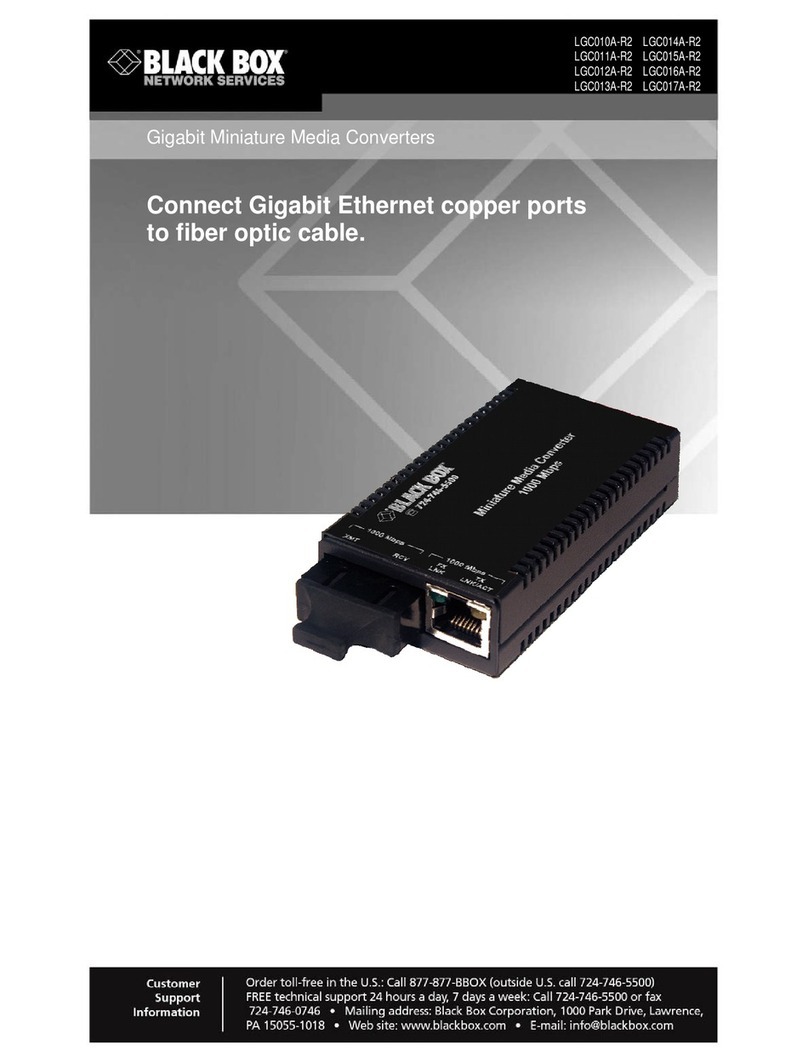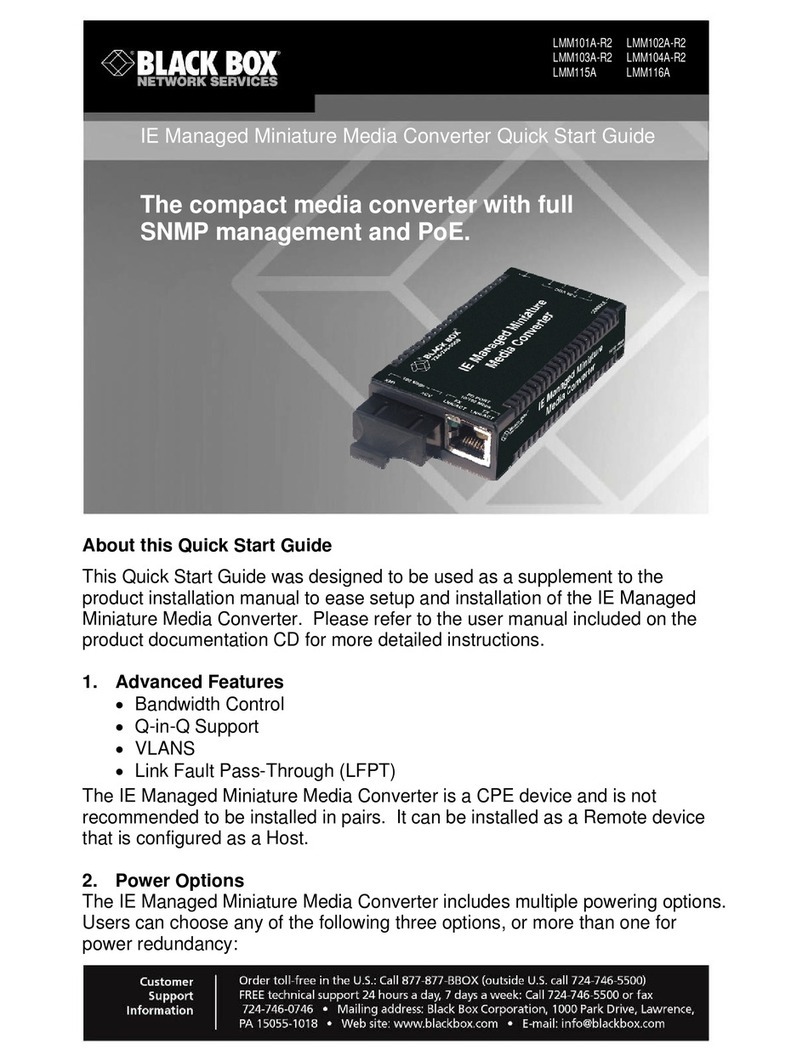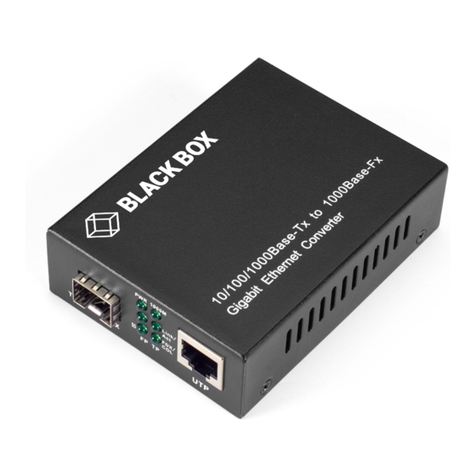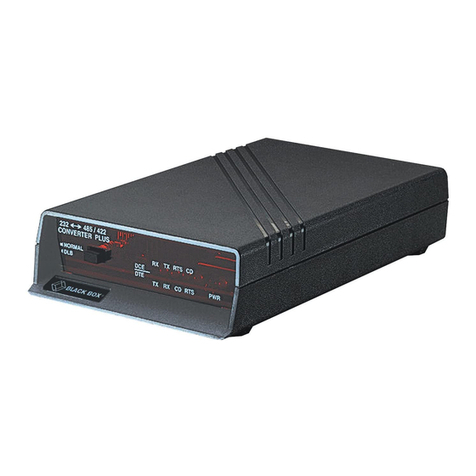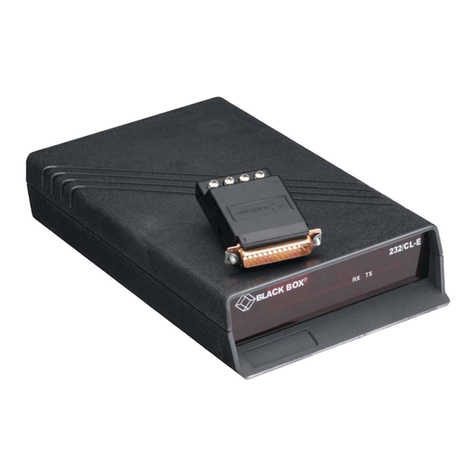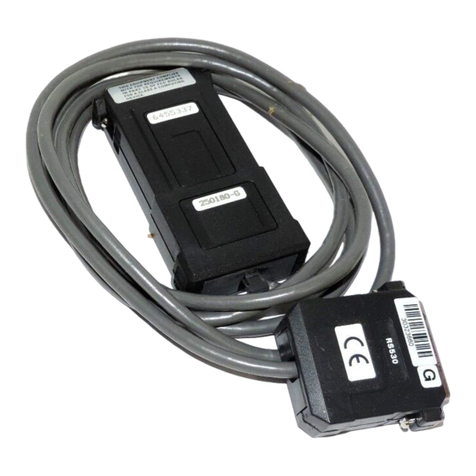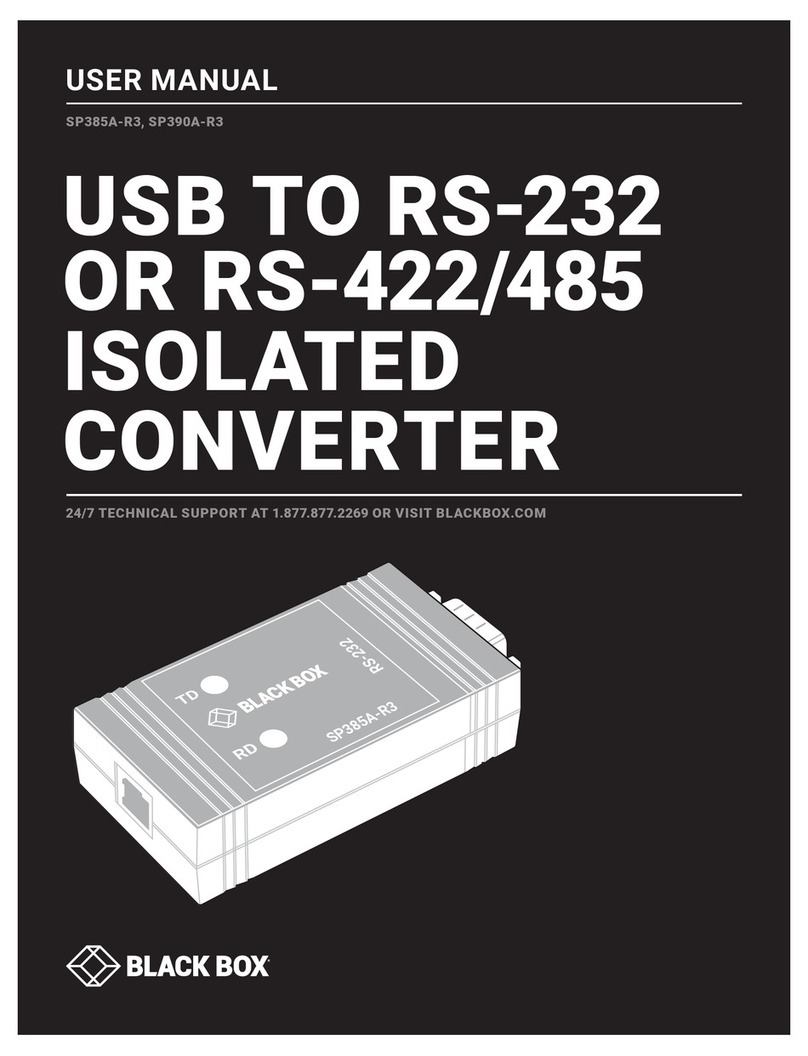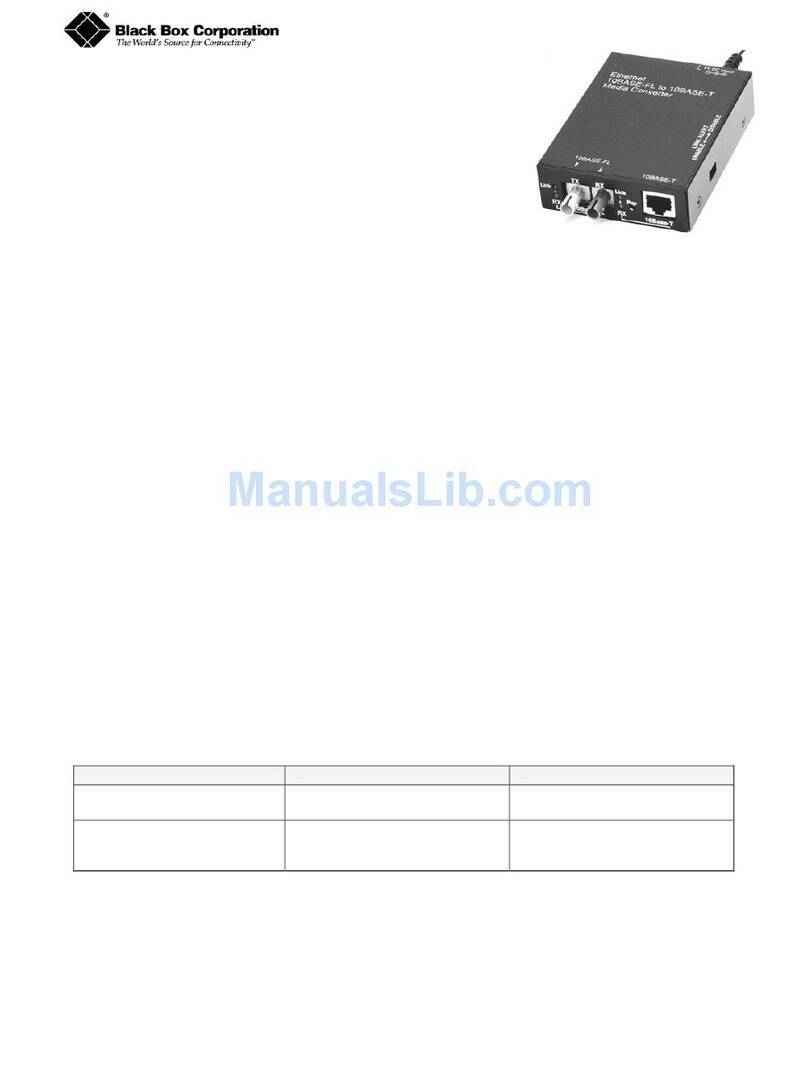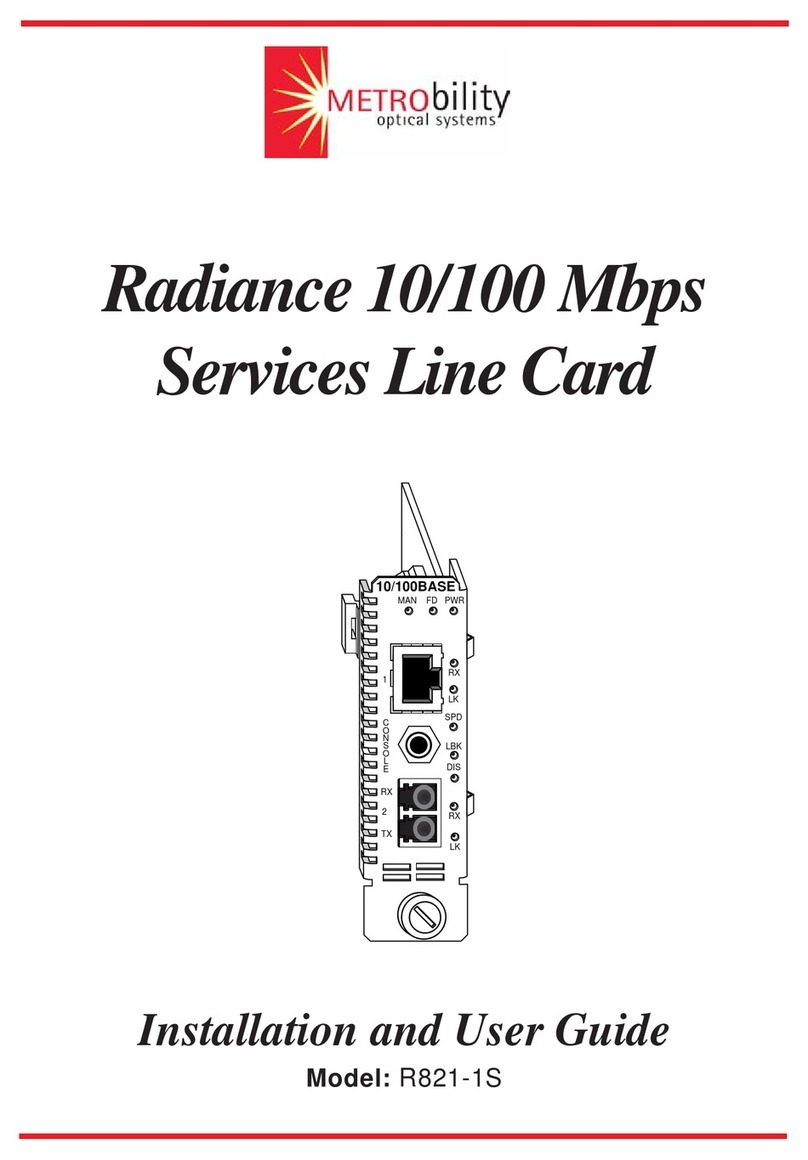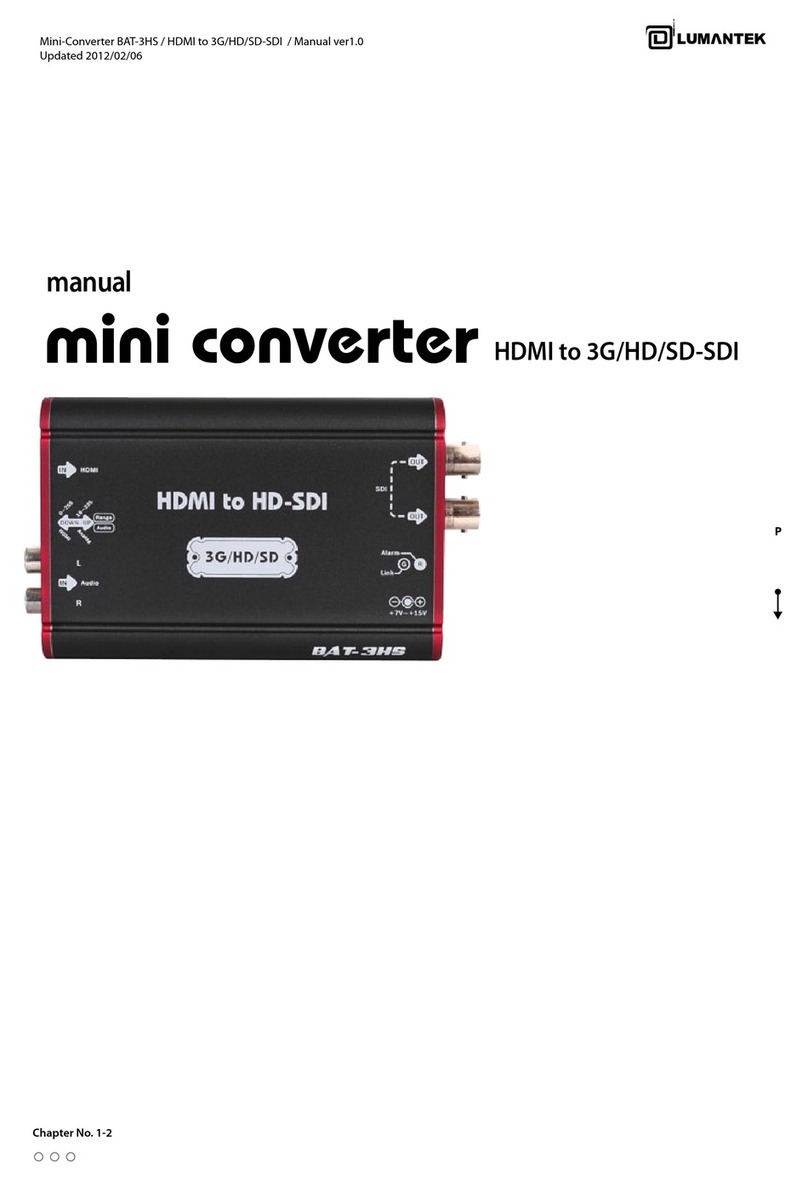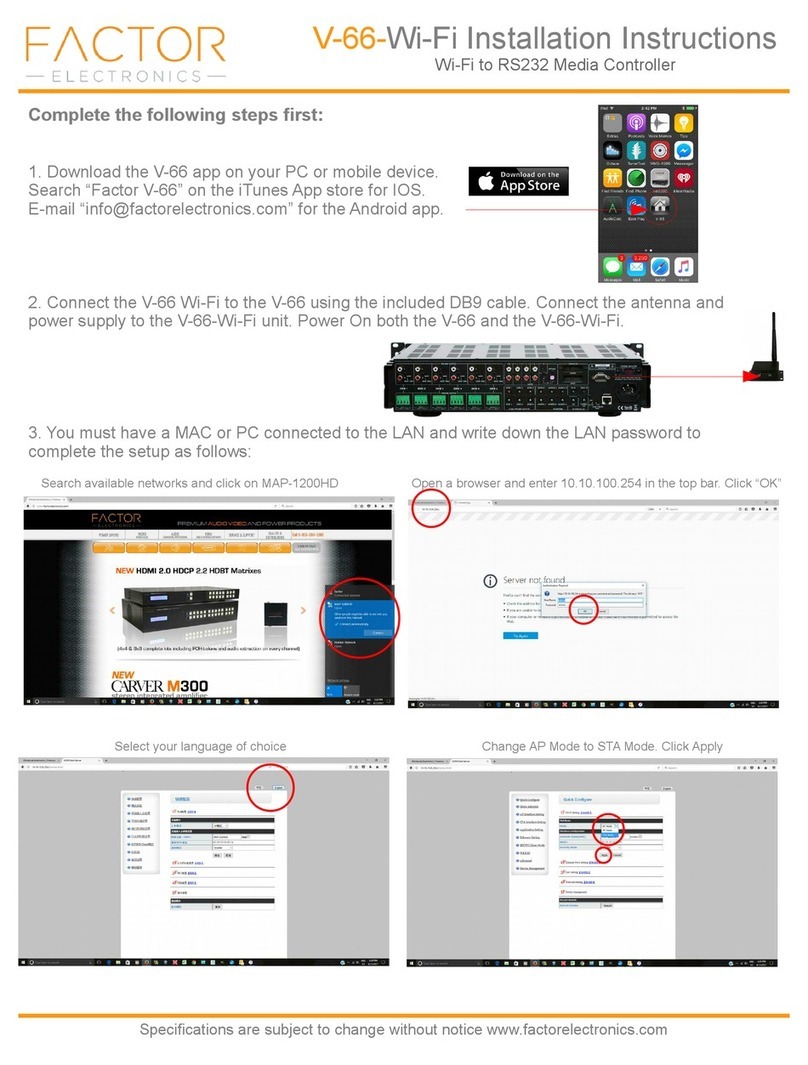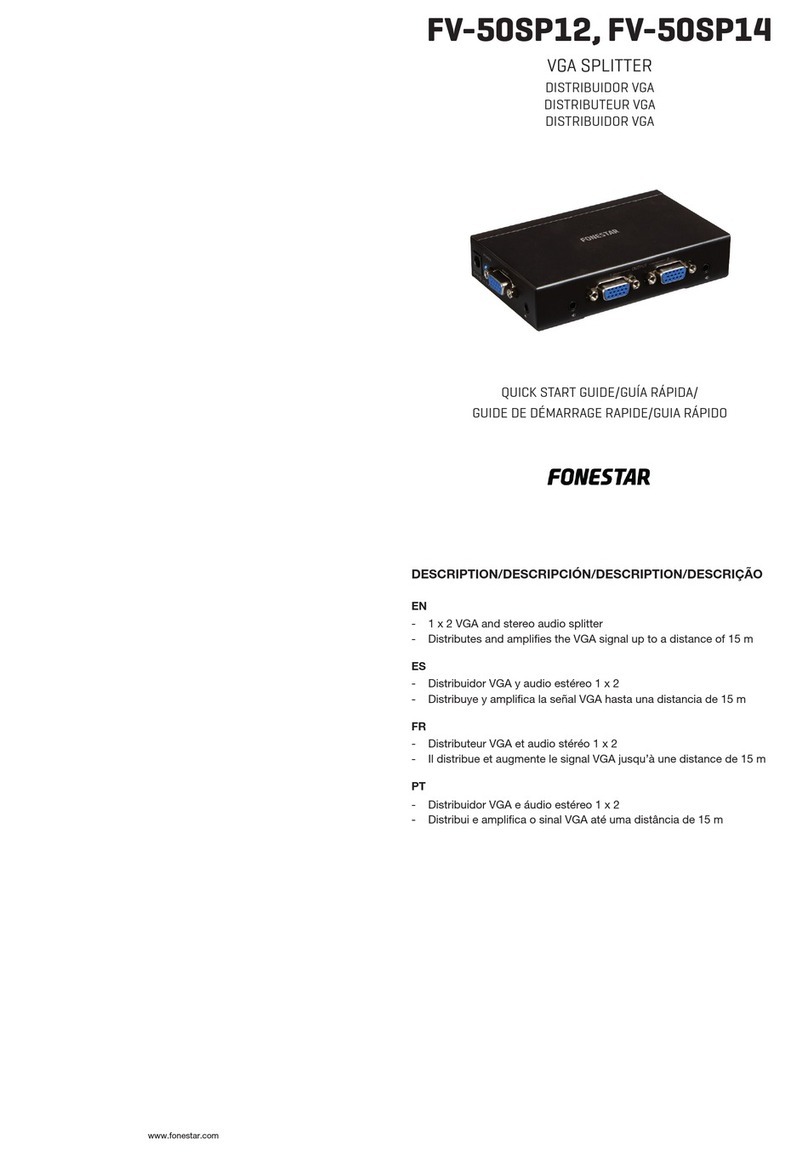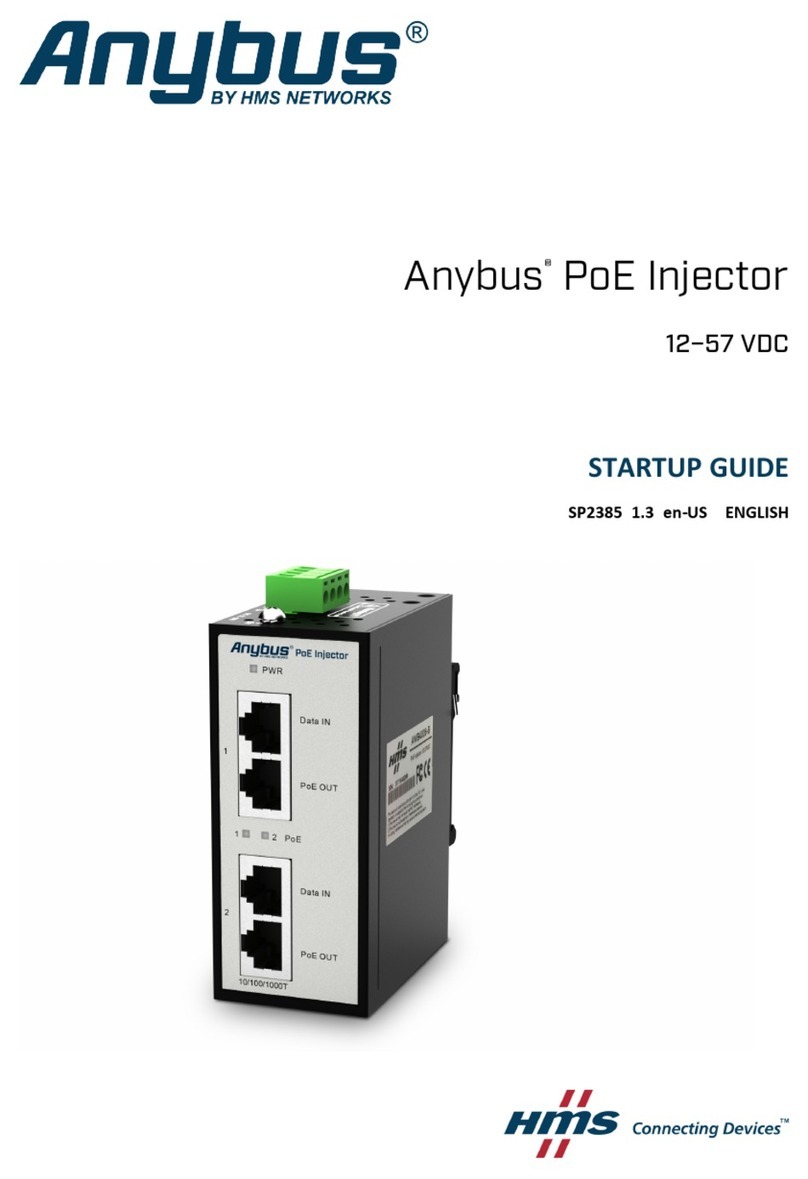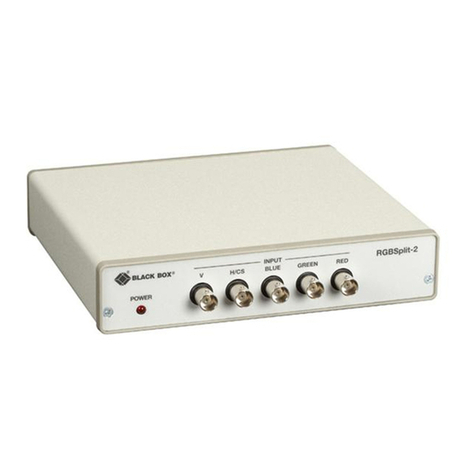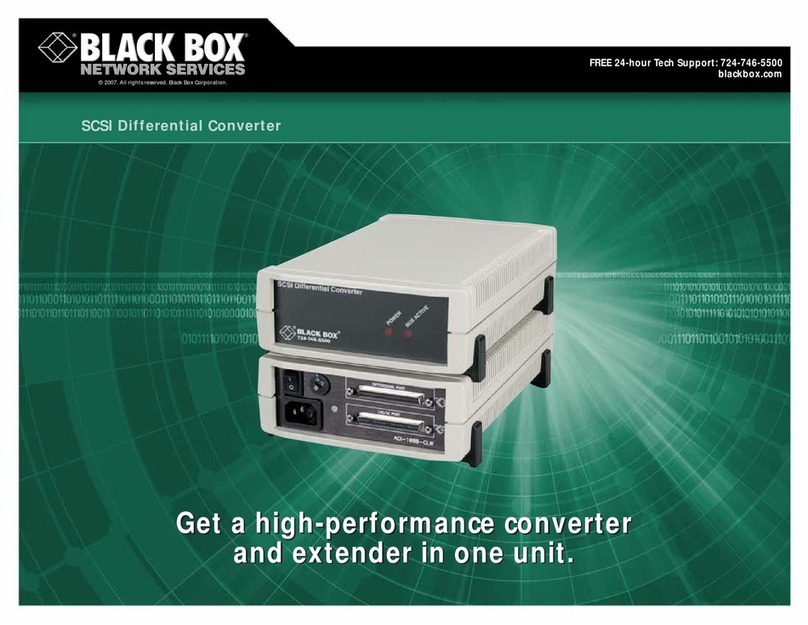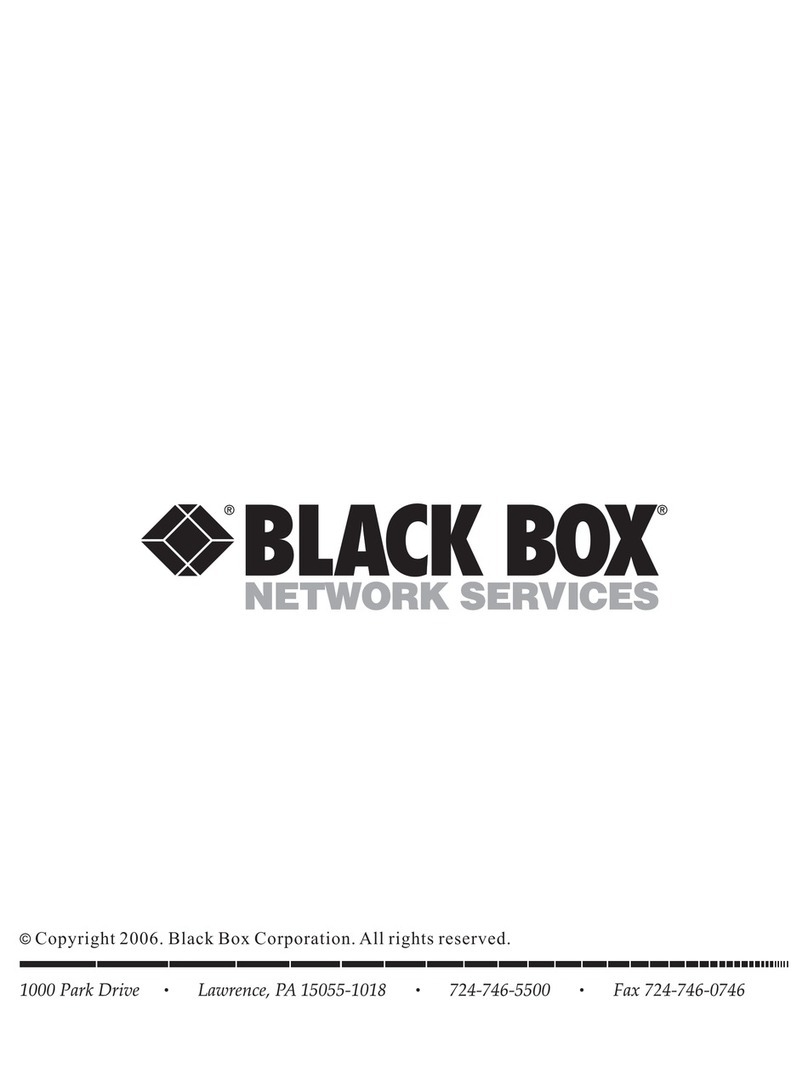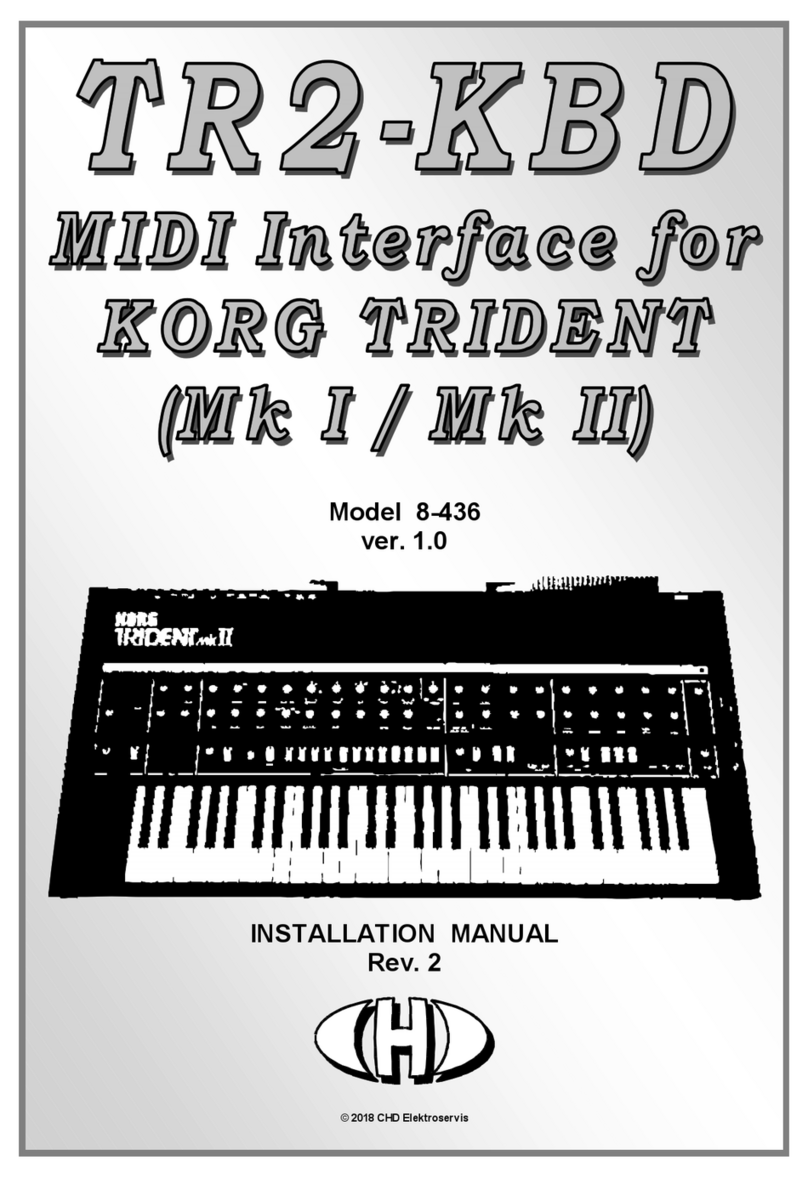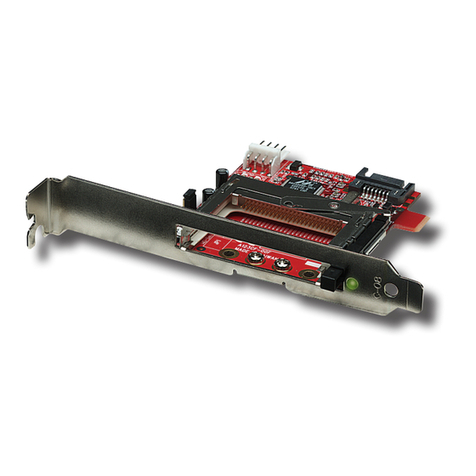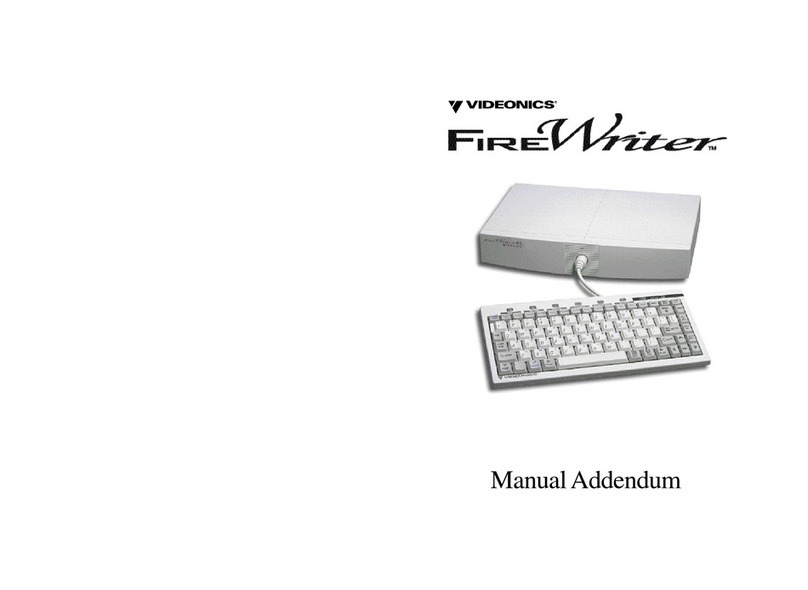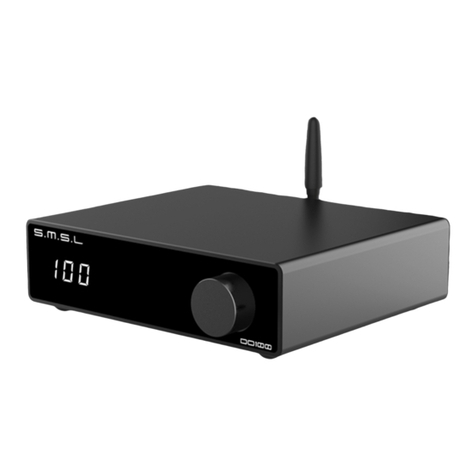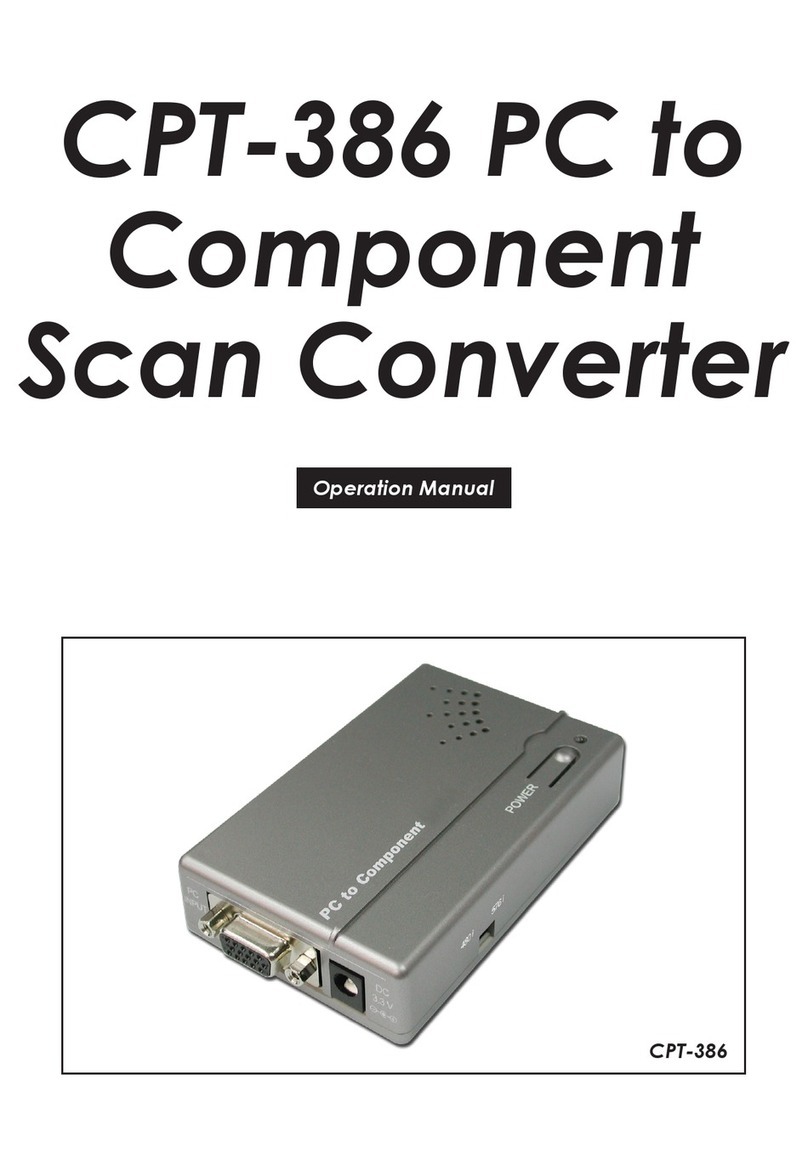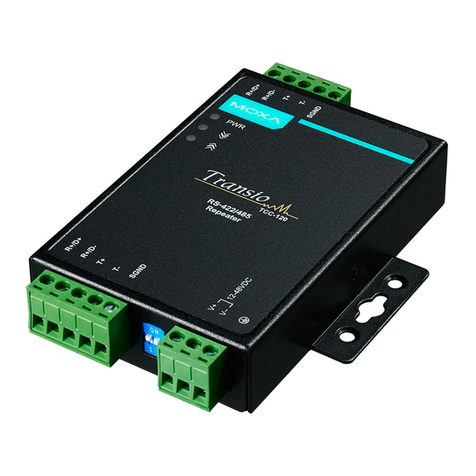Page 1 Page 2 Page 3 Page 4 Page 5 Page 6
Dynamic Fiber Conversion System
4Tx/L2 User Manual
Ordertoll-freeintheU.S.:Call877-877-BBOX
(outsideU.S.call724-746-5500)
FREEtechnicalsupport24hoursaday,7days
aweek;Call724-746-5500or fax724-746-0746
Mailingaddress: BlackBox Corporation,
1000ParkDrive, Lawrence, PA15055-1018
Website:www.blackbox.com
CUSTOMER
SUPPORT
INFORMATION
Description
The DFCS 4Tx/L2 is a 4-port 10/100 Ethernet Switch
Module that supports the IEEE 802.3 Ethernet standard
and allows connectivity between 10Base-Tand 100Base-Tx
unshielded twisted pair (UTP) devices on any of its
front-plane ports. The 4Tx/L2 fits the DFCS module
standard and can be used in any DFCS chassis.
The 4Tx/L2 supportsHalf-Duplexand Full-Duplex modes
and features an automatic cross-over UTP circuitry
that facilitates easy attachment to hubs, switches and
workstations.
All four front-plane ports operate in an auto-negotiation
mode and can auto-sense the proper speed and duplex
mode for optimal operation. All four front-plane ports
can be set via the network management to any desired
speed and duplex mode. Two of the four can also be
set manually via dip-switches.
The 4Tx/L2 can be used as a standard compact four-port
10/100 switch. It can also use its two additional 10/100
backplane ports to connect to adjacent modules and
accommodate flexible network configurations such as
in-band management and multi-module configurations.
The 4Tx/L2 can be used in an unmanaged or managed
fashion. When unmanaged, it can be installed in a chassis
withoutaSNMP andTelnetManagementModule(MGT).Tobe
managed, a MGT module must be installed in the same
chassis
Port Structure
Using a 6-port-switch design, the 4Tx/L2 features four
front-plane 10/100 UTP ports and two 10/100 Ethernet
backplaneports(“A” and “B”) that canconnectto adjacent
modules within the same chassis.
Thefour front-plane 10/100 portsare designated asP1-P4
where P1 is located at the top (closest to the power LED)
and P4 is at the bottom (closest to the fastener screw).
Whenthe 4Tx/L2 Aand B ports areenabled (using the“BP
A EN” or “BP B EN” dip-switches), they connect via the
chassis’ backplane to the slots to the left and right of the
4Tx/L2 module. When another switch-based module with
backplane port connections such as a 10/100T-Fx or a
MGT is installed in an adjacent slot, it can be connected
viathebackplane to the4Tx/L2to facilitate amulti-module
configuration.
Application Example
In-Band Managed Switch with Fiber Uplink
“A” Link “B” Link
Chassis
Backplane
10/100T-Fx Module
AB
Internal
10/100
switch chip
UTP
10/100 port
Fiber
100 port
4Tx/L2 Module
AB
Internal
10/100
switch chip
4-port 10/100 UTP
Switch
MGT Module
A
MGT
front /
back
select
MGT UTP
10 port
Fig. 1 In-Band Managed Switch with Fiber Uplink
Fig. 1, depicts a chassis with three modules plugged into
three of its adjacent backplane slots. The adjacent slots
areconnected via the backplaneusingthe A andB10/100
Ethernet links. In this example, a 10/100T-Fx (a 10/100
converter with fiber port) in the center slot connects to the
slot on its left using the A link and to the slot on its right
using the B link.
In this example, the module on the left is a MGT Module
and it connects via its A backplane port to the 10/100T-Fx
facilitating “In-Band” management (via the fiber uplink).
Themodule on the rightis the 4Tx/L24-portswitch module
and it connects via its B backplane port to the 10/100T-Fx
facilitating a 5-port 10/100 Ethernet switch with a fiber
uplinkconfiguration. This 3-module configurationprovides
an effective 5-port 10/100 managed switch with a fiber
uplink configuration.
This example shows how the 4Tx/L2 can be used as a
managed or unmanaged switch.
Board Mounted Dip-Switch Settings
Fig 2. Board Mounted Dip Switches
Backplane Port A “BP A EN” Dip-Switch
When the “BP A EN” dip-switch is in the “right” position
(factory setting), the A backplane Port is disabled and the
module is disconnected from the A backplane Link. When
in the “left” position, the A backplane Port is enabled and
connects the 4Tx/L2 to the A backplane Link.
Backplane Port A “BP A EN” Dip-Switch
When the “BP B EN” dip-switch is in the “right” position
(factory setting), the B backplane Port is disabled and the
module is disconnected from the B backplane Link. When
in the “left” position, the B backplane Port is enabled and
connects the 4Tx/L2 to the B backplane Link.
Port 1 “AN/MAN“ Dip-Switch:
When in “AN” (Auto-Negotiation) “right” position (factory
setting), Port 1 (P1) auto-negotiates and matches the
10/100 speed and duplex mode of a mating auto-
negotiating UTP port.
When in “MAN” (Manual) “left” position, the port does
not auto-negotiate and operates in the mode selected
by the P1 “10/100” and “HD/FD” dip-switches.
Port 1 “10/100” Speed Selection Dip-Switch
When the “AN/MAN” dip-switch is in the “MAN” position,
the P1 “10/100” dip-switch selects the speed of the P1
port. When in the right “100” position (factory setting),
P1 operates at 100 Mbps. When in the left “10” position,
P1 operates at 10 Mbps.
Port 1 “HD/FD” Full/Half Duplex Dip-Switch:
When the P1 “AN/MAN” switch is in the “MAN” position,
the P1 “HD/FD” switch selects the duplex mode of the P1
port.When in the“FD”(Full Duplex) “right”position (factory
setting), P1 operates in full duplex. When in the “HD”
(Half Duplex) “left” position, P1 operates in half duplex.
Port 2 “AN/MAN“ Dip-Switch:
When in “AN” (Auto-Negotiation) “right” position (factory
setting), Port 2 (P2) auto-negotiates and matches the
10/100 speed and duplex mode of a mating auto-
negotiating UTP port.
DFCS 4Tx/L2
Connector Type Distance Model
RJ-45 100 m LMC3050C
When in “MAN” (Manual) “left” position, the port does
not auto-negotiate and operates in the mode selected
by the P2 “10/100” and “HD/FD” dip-switches.
Port 2 “10/100” Speed Selection Dip-Switch
When the “AN/MAN” dip-switch is in the “MAN” position,
the P2 “10/100” dip-switch selects the speed of the P2
port. When in the right “100” position (factory setting),
P2 operates at 100 Mbps. When in the left “10” position,
P2 operates at 10 Mbps.
Port 2 “HD/FD” Full/Half Duplex Dip-Switch:
When the P2 “AN/MAN” switch is in the “MAN” position,
the P2 “HD/FD” switch selects the duplex mode of the P2
port.When in the“FD”(Full Duplex) “right”position (factory
setting), P2 operates in full duplex. When in the “HD”
(Half Duplex) “left” position, P2 operates in half duplex.
Note that attaching an auto-negotiating UTP port to a
non-auto-negotiating (manual / forced / hard-coded)
UTP port may result in an unpredictable port setting
with excessive collisions and poor link performance.
When operating in manual mode, both mating ports
MUST be set manually to the same speed and duplex
mode.
“RJ45 Cross-Over” Slide-Switch:
When the P1 “AN/MAN” switch is in the “MAN” position,
the “RJ45 Cross-Over” slide-switch controls the “Straight-
Through” or “Crossed” wiring of the P1 port. When
connecting P1 to a hub or switch, set slide-switch to the
“Switch” (factory setting) position. When connecting to a
workstation, set to “Workstation”.
040-L3050-001A 11/03
Page 7 Page 8 Page 9
TRADEMARKS
All applied-for and registered trademarks are the
property of their respective owners.
FEDERALCOMMUNICATIONSCOMMISSION AND
CANADIANDEPARTMENTOF COMMUNICATIONS
RADIOFREQUENCY INTERFERENCESTATEMENTS
This equipment generates, uses, and can radiate radio
frequency energy and if not installed and used properly,
that is, in strict accordance with the manufacturer’s
instructions, may cause interference to radio
communication. It has been tested and found to comply
with the limits for a Class A computing device in accordance
with the specifications in subpart B of Part 15 of FCC
rules, which are designed to provide reasonable protection
against such interference when the equipment is op-
erated in a commercial environment. Operation of this
equipment in a residential area is likely to be cause inter-
ference, in which case the user at his own expense will be
required to take whatever measures may be necessary
to correct the interference.
Changes or modifications not expressly approved by the
party responsible for compliance could void the user’s
authority to operate the equipment.
This digital apparatus does not exceed the Class A limits
for radio noise emission from digital apparatus set out in
the Radio Interference Regulation of the Canadian
Departmentof Communications.
Le présent appareil numérique n’émet pas de bruits
radioélectriques dépassant les limites applicables aux
appareils numéirques de las classe A prescrites dans le
Règlement sur le brouillage radioélectrique publié par le
ministèredes Communications duCanada.
NORMASOFICIALESMEXICANAS (NOM)
ELECTRICALSAFETYSTATEMENT
1. Todaslas instrucciones de seguridady operación deberánser leídas
antes de que el aparato eléctrico sea operado.
2. Las instrucciones de seguridad y operación deberán ser guardadas
para referencia futura.
3. Todaslas advertencias en elaparato eléctrico yen sus instrucciones
de operación deben ser respetadas.
4. Todas las instrucciones de operación y uso deben ser seguidas.
5. El aparato eléctrico no deberá ser usado cerca del agua—por
ejemplo, cercade la tinade baño, lavabo,sótano mojado ocerca de
una alberca, etc.
6. El aparato eléctrico debe ser usado únicamente con carritos o
pedelstales que sean recomendados por el fabricante.
7. El aparato eléctrico debe ser montado a la pared o al techo sólo
como sea recomendado por el fabricante.
8. Servicio—Elusuariono debe intentar darservicio al equipo eléctrico
másalláalodescritoenlasinstruccionesdeoperación.Todootroservicio
deberá ser referido a personal de servicio calificado.
9. El aparato eléctrico debe ser situado de tal manera que su posición
no interfiera su uso. La colocación del aparato eléctrico sobre una
cama, sofá, alfombra or superficie similar puede bloquea la
ventilación,no se debecolocar en libreros o gabinetes que impidan
el flujo de aire por los orificios de ventilación.
10. Elequipoeléctrico deber ser situado fuera del alcancede fuentes de
calor como radiadores, registros de calor, estufas u ostros aparatos
(incluyendo amplificadores) que producen calor.
11. Elaparatoeléctrico deberá ser connectadoa una fuente depoder sólo
deltipodescrito en el instructivo deoperación,ocomo se indique en el
aparato.
12. Precación debe ser tomada de tal manera que la tierra fisica y la
polarización del equipo no sea eliminada.
13. Los cables de la fuente de poder deben ser guiados de tal manera
que no sean pisados ni pellizcados por objetos colocados sobre o
contra ellos, poniendo particular atención a los contactos y
©Copyright 2003. Black Box Corporation. All rights reserved.
1000 Park Drive ·Lawrence, PA 15055-1018
724-746-5500 ·Fax 724-746-0746
receptáculos donde salen del aparato.
14. El equipo eléctrico debe ser limpiado únicamente de acuerdo a las
recomendaciones del fabricante.
15. Encasode existir, unaantena externa deberá ser localizada lejos de
las lineas de energia.
16. Elcablede corriente deberáser desconectado delcuando el equipo
no sea usado por un largo periodo de tiempo.
17. Cuidado debe ser tomado de tal manera que objectos liquidos no
sean derramados sobre la cubierta u orificios de ventilación.
18. Servicio por personal calificado deberá ser provisto cuando:
A: El cable de poder o el contacto ha sido dañado; u
B:Objectoshan caído o líquidohasido derramado dentro del aparato;
o
C: El aparato ha sido expuesto a la lluvia; o
D: El aparato parece no operar normalmente o muestra un cambio
en su desempeño; o
E: El aparto ha sido tirado o su cubierta ha sido dañada.
Page12
SPECIFICATIONS
Model 4Tx/L2
Protocols 10Base-T or
100Base-Tx
Connectors RJ-45
Controls UTP X-over (Port 1),
Auto/Man, 10/100,
FD/HD
LED
Displays Pwr, 10 link (1 per port)


